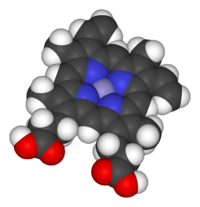
Photo from wikipedia
Heme has recently attracted much attention due to its promising applications in the food and healthcare industries. However, the current titers and productivities of heme produced by recombinant microorganisms are… Click to show full abstract
Heme has recently attracted much attention due to its promising applications in the food and healthcare industries. However, the current titers and productivities of heme produced by recombinant microorganisms are not high enough for a wide range of applications. In this study, the process for the fermentation of the metabolically engineered Escherichia coli HAEM7 strain was optimized for the high‐level production of heme. To improve the production of heme, different carbon sources, iron concentration in the medium, pH control strategies, induction points, and iron content in the feeding solution were examined. Moreover, strategies of increasing cell density, regular iron supplementation, and supply of excess feeding solution were developed to further improve the production of heme. In the optimized fermentation process, the HAEM7 strain produced 1.03 g/L heme with productivity of 21.5 mg/L/h. The fermentation process and strategies reported here will expedite establishing industry‐level production of heme.
Journal Title: Biotechnology and Bioengineering
Year Published: 2022
Link to full text (if available)
Share on Social Media: Sign Up to like & get
recommendations!